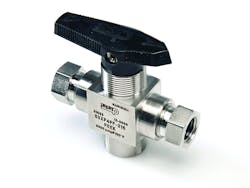The 83 series family of ball valves is ideal for high pressure/severe service, such as offshore control panel applications. The 83 (2-way) and 83X (3-way) designs have a maximum working pressure of
6000 psi (415 bar) and H83/H83X are rated to 10,000 psi (689 bar). All feature a 316-stainless steel, Alloy 400 or UNS N10276 body, and a variety of seats. Operating temperatures range from 0° to 4500° F (–17 to 2320 C), with optional low-temperature service rated at –40° to 2000°F (-40 to 930°C).
SSP, (330) 425-4250,
Click here for more information.


